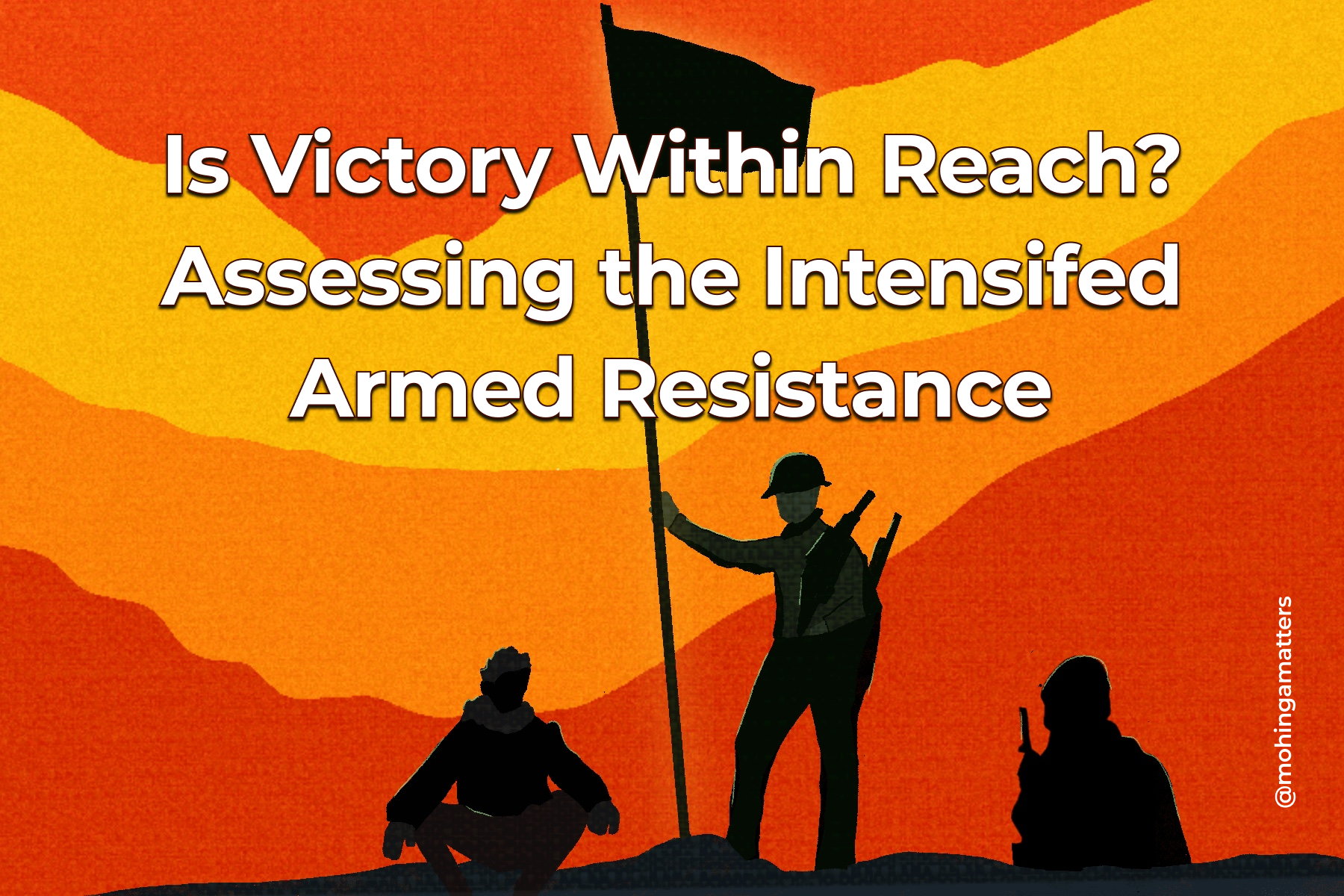
November marked significant progress in the armed resistance against the regime in Myanmar. Operation 1027, now a month underway, has resulted in the capture of over 220 stations by the Three Brotherhood Alliance. Notably, three towns in Chin State were successfully occupied by the Chin Resistance Forces in November alone. Meanwhile, the struggle for control over Loikaw, the capital of Karenni (Kayah), persists between the regime’s weakened battalion and the Karenni resistance forces. Concurrently, the National Union Government (NUG) has commenced administrative tasks in the Sagaing Region. To gain a realistic understanding of the situation on the ground amidst our high expectations, we interviewed Saw Nay Toe (an alias), an experienced journalist specializing in the armed resistance since its inception.
MM: First of all, tell us how you feel regarding the great achievements of the resistance forces on the battlefields.
SNT: Operation 1027 has certainly provided a major boost to the morale of the people. People have started to believe the end of the dictatorship is within reach, it’s only a matter of time before reuniting with their families. The same applies to the resistance forces. They now believe the time to go home is soon. To be fair, the armed resistance has lingered on for more than two and a half years. Doubts had surfaced among the populace. And Operation 1027 served as a lifeline in bolstering people’s faith in the cause.
MM: How accurate is the news about victories on the ground? There have been doubts about the reported number of casualties on the junta’s side by the resistance media.
SNT: The accuracy of casualty reports in the media depends on the nature of the incidents. For casualties resulting from landmine detonations or guerilla attacks, accuracy can be low, probably at around 50-50 since there is no proper verification method. However, in urban conflict situations, there is graphic evidence available – the number of injured or killed soldiers, and confiscated weaponry. Then, the reporting can be accurate. It’s also crucial to consider the context. In November, initial reports indicated that the northern alliances had occupied Kun Long Town in Shan-north. Many celebrated this news, assuming complete control by the resistance forces. In reality, one battalion unit of the regime still holds ground in Kun Long, which has not been defeated. In that case, we can only say the town is partially controlled by the resistance forces, not entirely captured. A similar scenario exists in Kawlin Township from Sagaing Region as well.
MM: In November, we witnessed the Karenni resistance forces almost taking over Loikaw. They visited the famous pagoda there, raided the University, evacuated the staff, and burned down the regional court. However, officially, Loikaw remains under the regime’s control on paper. As we speak, Mese is the only town that is controlled by the anti-regime forces in Karenni State. What does it mean?
SNT: Since mid-2023, the regime’s forces have been forced to switch to a defensive strategy. Their soldiers are too tired and they have not got many chances to go home after several months on the war front, for such reasons, they lack motivation to fight. Moreover, they are reduced to limited space even in their own stations due to the increasing drone usage by the resistance forces. Amid all this, an average soldier is more inclined to abandon their post than engage in combat. Instances of station capture by the resistance forces often occur when regime units stationed in a town either abandon or surrender to their opponents, especially when commanding officers sympathize with the people.
However, there remains a handful of commanders on the regime’s side resolute in defending their positions. When that mentality is coupled with the regime’s substantial firepower, the occupation process takes far longer. A similar instance took place in Kyaikmayaw Town in Karen State in November. The Karen National Union (KNU) forces managed to occupy the town entirely, except for the police station. The battle has persisted for weeks because the police refused to surrender. Loikaw presents a similar scenario, with an entire battalion that is still operating within their compound. Nevertheless, their defense will not last forever. They will eventually give in since the regime is in no position to send reinforcements.
MM: Please elaborate on the lack of motivation within the regime’s army.
SNT: The demotivation within Min Aung Hlaing’s army stems from several factors beyond the absence of official leaves. Most of the soldiers who are in the regime’s army today must have enlisted at a young age, around 18 or so. Since then, they have been consistently subjected to misinformation and propaganda from the junta, leaving them politically blind. However, their families reside outside this ideological bubble and are influenced by society. Out of either fear or moral conviction, these families now encourage soldiers to defect and join the Civil Disobedience Movement (CDM). Besides, the troops have been fed up with Min Aung Hlaing’s unfulfilled promises of transferring power within a year, which have been repeatedly extended. Both the public resentment and mistrust of their leader have led to mental distress among many. Initially observed among infantry soldiers, the perspective has now been seen in the higher ranks, including major levels, and causing increased participation in the CDM.
MM: Operation 1027 in Shan-north has entered its second month. Initially, there were doubts about whether this operation solely targeted Chinese online scams rooted in the region. Now, it appears that the Myanmar National Democratic Alliance Amry (MNDAA) is poised to take over Laukkai while the Ta’ang National Liberation Army (TNLA) is making efforts to dominate the vital trading zone in Muse. What lies ahead for them?
SNT: Operation 1027 was planned at least one year in advance. While combating online scams was one of its objectives to garner support from China, the primary aim remains the eradication of the military dictatorship. However, there are geographical limitations to their actions. The MNDAA might cease operations after capturing Laukkai (which could be any day now), and similarly, the TNLA may conclude its efforts upon reaching its goal. But it does not mean they are no longer involved in the armed resistance. Just as the resistance forces supported Operation 1027 by contributing manpower, the alliances are expected to aid in clashes in other regions. Of course, the MNDAA won’t mobilize its entire unit to capture the Mandalay Region, but it will support local forces in their efforts. Ultimately, the responsibility for capturing their respective regions rests with the local resistance forces.
MM: What’s the stance of the United Wa State Army (UWSA), which recently declared its non-involvement in military operations?
SNT: Kokang, Wa, and Mongla share common economic and political interests. Although some members may not directly participate in ground combat, they could be providing support through alternative means. Chinshwehaw Town, situated adjacent to the Wa State, has now been captured by the alliances. The capture implies that the UWSA might have offered its approval since taking control of the town would have been difficult without it. This observation leads to speculation that the UWSA might not strongly oppose the idea of forming a federal state in Myanmar.
MM: On the other side of the country, the Chin Resistance Forces captured Reh Khaw Da, Lai Lin Pi, and Rezua towns in Chin State. What do you make of this development?
SNT: It is important to recognize that states like Kayah (Karenni), Chin, Shan-north, and Rakhine possess unique advantages in armed resistance. Firstly, their geographical terrain—characterized by dense forests, hills, mountains, and gullies—serves as strategic hideouts for the resistance forces. In contrast, Magway and Sagaing regions, abundant in plains rather than mountains, pose challenges as battlefields. Secondly, the resistance within these states originates from the entire populace, fostering an unbroken fighting spirit. However, in Chin State, the quest for freedom has faced delays due to limited access to diverse firepower, primarily due to challenging logistics routes. Additionally, neighboring India’s overt support is lacking. In many areas, reliance on handmade “Tumee” guns persists. If Chin State could be equipped with potent firearms, it would significantly bolster the armed resistance effort.
MM: Town takeovers are occurring in the Sagaing Region as well. How do you anticipate the regime will respond? Do they possess the capability to execute simultaneous full-scale counteroffensives?
SNT: Undoubtedly, the regime will initiate counter-insurgency operations. The generals are likely to let go of certain areas temporarily to consolidate their forces. Subsequently, they will likely employ advanced spyware to gather and collect military intelligence and executive excessive bombings or aerial strikes targeting the resistance groups. At the same time, they will attempt to incite racial and religious conflicts, which in my opinion will no longer work.
MM: Is it a possibility that ethnic regions will achieve independence while the Bamar region remains under regime control?
SNT: This concern resonates with many. The regime has historically attempted to curb the intentions of the Ethnic Armed Organizations (EAOs) with sugarcoated promises, such as the Nationwide Ceasefire Agreement. The generals have always presumed that the plains, primarily inhabited by Bamar ethnics, would remain secure for them, which is no longer the case in this revolution. I doubt such a division will materialize. When the EAOs gain ground, it’s more probable they’ll strive for further territorial control rather than simply accepting the junta’s offer to retain certain locations.
MM: We haven’t heard much about activities from prominent groups like the Kachin Independence Army (KIA) and the Karen National Union (KNU). Were there any significant events we missed in November?
SNT: The timing and nature of conflict initiation vary across states and regions. For instance, Operation 1027 commenced in Shan-north during the harvest season in the Karen and Bago regions. Engaging in clashes during this period would disrupt the harvest, impacting food production. Villages might face artillery fire from the regime, leading to civilians becoming Internally Displaced Persons (IDPs) instead of harvesting crops. Therefore, certain times of the year are avoided for strategic reasons. Additionally, some EAOs refrain from publicizing their actions to avoid drawing unnecessary attention from the junta. In mid-November, the KNU successfully took control of two stations in Brigade 5 & areas, but no official statement was released to avoid inviting an escalated response. Such occurrences indicate ongoing activities across regions, although some deliberately stay out of the spotlight.
MM: Can discussions regarding what comes after the revolution or the “end game” be openly conducted, or is it still a sensitive topic?
SNT: There exists a group called “The Seven,” comprising members from the National League for Democracy (NLD) and influential EAOs. This group has been actively engaged in discussions concerning the post-military dictatorship era. Currently, these discussions have been relatively discreet. However, the plan is to eventually expand these dialogues nationwide when the time is deemed appropriate.

